

Vol. 40 (Issue 42) Year 2019. Page 8
ANDREEV, Oleg 1; GREBENKINA, Svetlana 2; LIPATOV, Andrey 3; ALEKSANDROVA, Ariadna 4 & STEPANOVA, Diana 5
Received: 09/07/2019 • Approved: 04/12/2019 • Published 09/12/2019
ABSTRACT: Information and communication technologies (ICTs) are a major factor that contributes to the global development of the world economy. ICTs in developing economies support competitiveness and are the driving force of the economic development. Research on the information technology development is often focused on a small number of advanced countries. This study illuminates the place of developing countries in the global ICT development by comparing the ICT Development Index values according to regional, time-based, and socio-economic criteria. and refutes A hypothesis speculating about the dependence of ICT development and per-capita GNI was rejected graphically through the use of representations that showcase the distribution of these values across an array of countries. Research findings show that an active ICT development is the most optimal way to achieve social welfare if the country if short of raw materials and capital. Hence, ICT clustering may be considered a new means of competition, which is based on the human capital. |
RESUMEN: Las tecnologías de la información y la comunicación (TIC) son un factor importante que contribuye al desarrollo global de la economía mundial. Las TIC en las economías en desarrollo apoyan la competitividad y son la fuerza impulsora del desarrollo económico. La investigación sobre el desarrollo de la tecnología de la información a menudo se centra en un pequeño número de países avanzados. Este estudio demuestra el lugar de los países en desarrollo en el desarrollo global del sector de las TIC, al comparar los datos del índice de desarrollo de las TIC de acuerdo con criterios regionales, temporales y socioeconómicos, y refuta la hipótesis sobre la dependencia del desarrollo de las TIC en un estado particular con el nivel de INB per cápita a través de una tabla de distribución de datos de valores de 150 países. Según los resultados del estudio, se determinó que el desarrollo de las TIC para los países en desarrollo es la forma más óptima de lograr el bienestar de la sociedad en el contexto de la escasez de materia prima y capital, lo que nos permite hablar sobre la agrupación del sector de las TIC como una nueva forma única de competencia con los países desarrollados, basada principalmente en capital humano. |
The modern-day concepts of national and regional development are tightly connected to IT technologies, primarily due to the deepening of globalization because of which IT technology has spread all spheres of global society around. In this way, developing countries have obtained new opportunities for growth, those that were not based on raw materials (Stanley et al., 2018). As more information became widely available to a diverse range of people, countries that were unable to produce welfare-ensuring goods during the industrial era, for the shortage of educated personnel and capacities, received a tool for such a purpose. Hence, these countries become able to educate employees and produce high-tech goods that would create added value and fill the budget (Das et al., 2018).
On the one hand, developed countries continue to hold the position of a technology center, which allows them to significantly transform the economic system. On the other hand, developing countries were granted a significant part of technology ‘goodies’ through outsourcing, outstaffing and the opening of enterprise branches (Niebel, 2018). In such wise, both sides win; developed countries do not have an imbalance in employment so that business can manage profitability with higher effectiveness, and developing countries acquire an employed population who pays taxes and ensures the household welfare (Jamali & Karam, 2018).
In addition, technological development leads to economic virtualization, both in government and business institutions. The concept of electronic government (e-Government) where social services are remotely provided to the population can be considered largely an anti-corruption tool. From this perspective, having an e-Government is crucial for the developing countries (Ali et al., 2018). Considering e-Government as a form of digital interaction, one between the government and the population, note that it provides an equal access to services and opportunities for citizens regardless of their social status, thereby strengthening the foundations of civil society. Business virtualization as a path discovered in consequence of IT development optimizes the costs of commercial organizations, allowing them to earn more, and therefore, pay higher salaries and taxes (Ziemba, 2019). Virtualization is turning into a unique solution for businesses in developing countries that have a difficult geopolitical position, especially in the context of institutionalization processes that occur in the international trade (e.g., regional sanctions, customs barriers, political disputes about transit zones).
According to Dinçer H., Yüksel S., Adalı Z. and Aydın R. (2019) the development of information technologies should ensure the development of a distribution logistics network, which includes an efficient transport system and provides better delivery of goods and services, as well as improved labor mobility. Palvia P., Baqir N. and Nemati H. (2018) argue that economic development is not only focused on the ways to accelerate structural changes and economic growth, but also on the increase of the population potential; for example, through education and health care. Globalization has changed the world economy. It has increased cross-border trade, currency exchange, free capital flow, movement of people and the flow of information (Latif et al., 2018). Globalization has given a new direction to business all over the world as with the development of information technology, many strategic changes have occurred in the economy. Therefore, the future of developing countries largely depends on the development of information technologies in the political, economic and social spheres of global society.
Based on ITU data (annual reports), the time series that reflect the degree and quality of ICT development in the world between 2001 and 2017 were constructed. Hence, the ICT development pattern for the indicated period in countries having different socio-economic levels of development was histographically determined. Using the comparable ICT development indices, the regional affiliation of ICT leaders was identified for the following years: 2005, 2010, 2015 and 2017 (the last year of representative data collection). According to data obtained, a hypothesis concerning the correlation between the ICT development levels and GNI level was tested be means of a graphical representation of the ICT development index and per capita GNI values reported by UN, UNCTAD and OECD with respect to 150 countries.
A quantitative assessment of the ICT sector may be rather inconclusive, as these technologies have a social effect on users. The most appropriate measure of ICT development is the ICT Development Index (IDI), a composite indicator calculated according to the International Telecommunication Union (ITU) guidelines. The index combines three sub-indexes, a total of 11 indicators into one benchmark measure that serves to compare ICT developments across countries and can be used as a tool in comparative analysis conducted at the global, regional and national levels. Index components capture the access, use, and skill aspects of ICT. The international practice of using this index and methodological transparency allow utilizing this tool as an adequate measure of ICT status in society.
In the global context, the spread of ICT in the 21st century is characterized by a variable growth rate, meaning that some technologies are developing faster compared to other technologies (Fig. 1).
Figure 1
Global ICT developments
2001-2017*
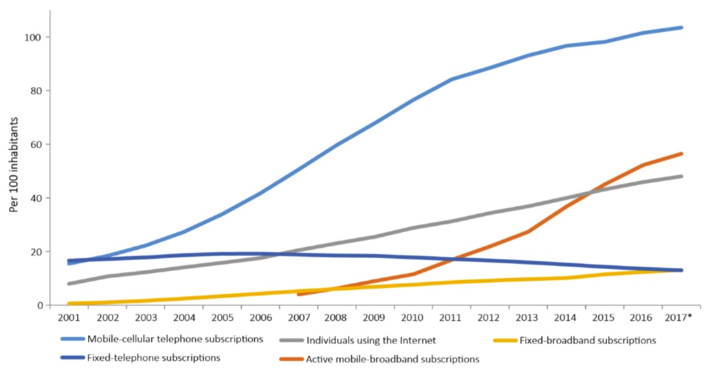
(source: ITU data)
Notes: * ITU estimate
According to the graph above, the ICT sector largely drives on the public and technological demand for the remote communication tools. This connection is clearly evident from a fivefold increase in the number of mobile subscribers against a reducing number of fixed-telephone users.
Because the high-tech ICT industry requires a developed economic infrastructure, the ICT development tendencies need to be determined for different socio-economic conditions.
Global ICT access and use, selected years, by development status
Figure 2
Mobile-cellular telephone infrastructure,
subscription number
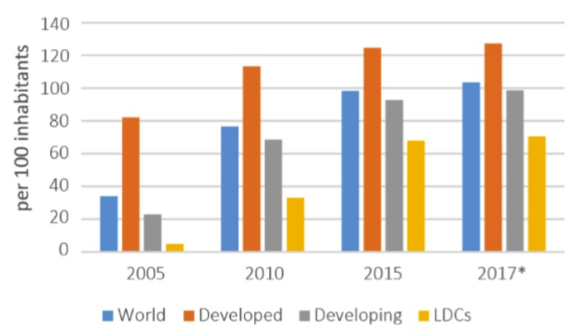
(source: ITU data)
Notes: * ITU estimate
According to data in Fig. 2, the change of mobile phone subscription numbers in all categories tends to be in line with the world trend but developing countries demonstrate the most compliance. The reason for this can be both the lower (non-)tariff barriers that restrict imports or exports of new goods and services in the emerging markets and the nominal distribution of technology without infrastructural reinforcement and consumers, who are willing to pay for it, in the developed markets.
Figure 3
Active mobile-broadband infrastructure,
subscription number
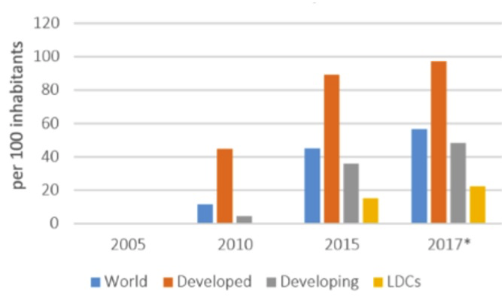
(Source: ITU data)
Notes: * ITU estimate
Fig. 3 shows that the infrastructure development in the emerging markets takes place at the fastest pace compared to other markets. Of course, such dynamics can be associated with the predominance of developing countries in the world (they made up early half of the global economy in 2014, according to (Morgan Stanley,2014). On the other hand, the least developed countries had their mobile-broadband infrastructure non-existent or weak during the period 2005-2010, due to the lack of financial resources. In other words, to attain infrastructure leadership, developing countries had to purposefully accumulate and direct their funds. This refers either to data democratization or to fund rising from goods with a high added value instead of energy. Thereby, there is a need to assess the infrastructure dynamics as well as changes in the number of private Internet users to determine the root of the broadband infrastructure development.
Figure 4
Individuals using the internet
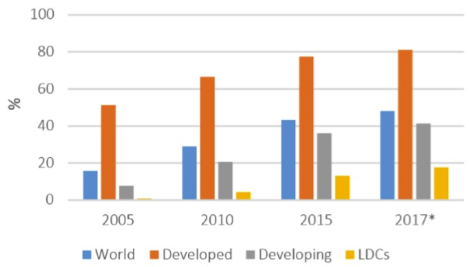
(source: ITU data)
Notes: * ITU estimate
Data in Fig. 4 demonstrate that the increase in the number of Internet users in developing countries corresponds to the infrastructure development dynamics (Fig. 2). This confirms the assumption made about the infrastructure development depending primarily on the public demand for information availability, rather than industrial demand for high-tech industries.
Historically, resources are distributed unevenly (due to colonialism). For that, there is a need to determine the geographical distribution of indicators (Figures 2, 3, 4) in order to assess the contribution of individual regions to the global ICT development.
Global ICT access and use, selected years, by region.
Figure 5
Mobile-cellular telephone subscriptions
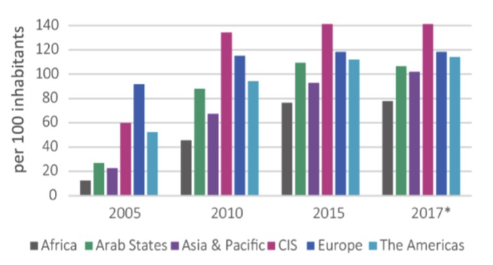
(source: ITU data)
Notes: * ITU estimate
The CIS region is the absolute leader in terms of mobile-cellular subscribers, although it has the smallest population along with the Arab countries. The reasons for such a leadership lie in the historical experience of the CIS countries that were formerly part of the USSR. For instance, many social ties were broken after the collapse of the USSR and mobile communications allowed people to communicate remotely with individuals living in another country. By association, Africa and Asia lag behind other regions in the ranking because of their past colonial experience. Thus, people did not travel outside the boundaries of their local community. As a result, distance communication is not relevant for them because families and the community live together and are always available for communication.
Figure 6
Active mobile-broadband subscriptions
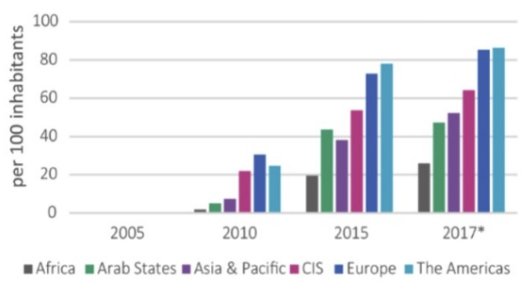
(source: ITU data)
Notes: * ITU estimate
The South and North America, Europe and the CIS region are the world’s ICT leaders. Since South and North America are considered one region in the ITU reports, it would be improper to assess the leadership of individual countries here. At the same time, the European leadership in broadband infrastructure is largely connected with the requirements, which are imposed for network data protection. The broadband infrastructure in the CIS region is well developed due to the large number of service consumers and a competition between network providers.
The private users determine the vector of ICT development at the macro level, as confirmed by Fig. 7. As mentioned earlier, individuals using the Internet need their personal data to be protected. Therefore, regions with many users became the first to issue rules and regulations for the use of Internet. However, the quality of such regulatory acts is highly dependent upon the processes of socio-economic development in the society. Therefore, the most successful forms of regulation are most often result from the experience of developed countries.
Figure 7
Individuals using the internet
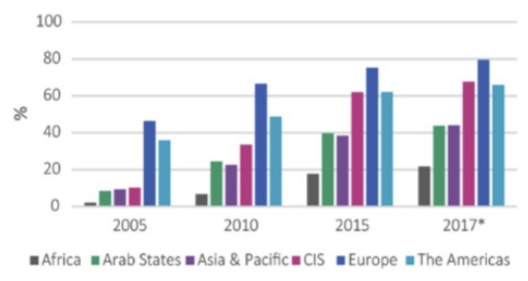
(source: ITU data)
Notes: * ITU estimate
Traditionally, developed countries are defined as countries with a high GNI per capita. However, in addition to the shortcomings associated with the GNI calculation, this quantitative indicator de facto does not reflect the quality of life of the population and therefore does not directly correlate with the level of ICT development in the country. In spite of that, it is the GNI that individual governments and international organizations use when arguing the lack of ICT advancement. Hence, a graph below is aimed at refuting a hypothesis, which assumes a dependence of these two aspects of population welfare. The absence of a direct relationship between the per-capita GNI and IDI is clearly evident from data in Fig. 4, which shows the distribution of thereof across 150 countries.
Figure 8
IDI and GNI per capita, 2017
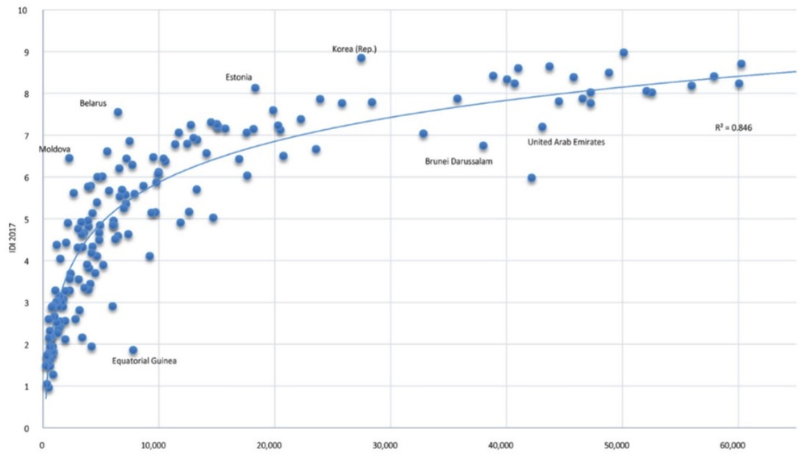
As it can be seen, the ICT sector is well developed both in industrialized countries like Korea and the United Arab Emirates, and in developing countries such as Moldova and the Republic of Belarus. Hence, one can claim the lack of asymmetry in the access to ICT, which presumably is conditional upon the capital intensity of economy. This finding equally proves the leveling effect of globalization and the high ICT potential of developing countries, which is based primarily on human capital that allows competition with other countries.
The analytical study conducted on different scales (i.e., sub-sectoral, regional and global) thus shows that further strengthening and clustering of the ICT sector in developing countries within the framework of international cooperation (trade unions, regional associations, and international production projects) may become a unique form of competition, stimulating changes of geopolitical and investment interests.
According to Stewart F. and James J. (2019) the information technology development provides free and easy access to information, its use and distribution. The information technology development brings profound qualitative changes in all spheres of life. The version of the development of “sectoral” information technologies presented in Bhattacharya R. (2019) was based on the interdependence between IT and other fields of activity Pradhan R.P., Mallik G. and Bagchi T.P. (2018) Scientists argue that information innovation systems can be differentiated in several ways: geographically, by sector, by activity. Geographically defined information systems can be local, regional, national, and supranational. This type assumes that the area in question has a reasonable degree of “consistency” or “inner orientation” in relation to information technology innovations.
The issue of digital information inequality of countries was mentioned in scientific literature for the first time as a relationship between the provision of information services Majeed M.T. and Ayub T. (2018) The digital divide, inequality in access to ICT between countries and communities can be explained by many factors: access to infrastructure, high cost of access, inappropriate or weak policy, inefficient telecommunications network, lack of local content (Lwoga & Sangeda, 2019).The divide is generated by the environment in which disadvantaged society groups can’t contribute to and benefit from the information technology and global communities.
As was noted by Ramanadham V. V. (2019), IT gives less developed countries the opportunity to move from industrialization and transform their economies into high value-added economies that can compete with the developed economy on the world market. Technological innovations have contributed to globalization by supplying infrastructure for trans-world connections. According Salam S., Zeng J., Pathan Z. H., Latif Z. and Shaheen A. (2018), the ICT revolution was the central driving force of globalization. Both developed and less developed countries can’t lose the opportunities created by these technologies.
We do not share the Billon M., Crespo J. and Lera-López F. (2018) that in practice, those who have the technology, resources, contacts, information and access to markets benefit from globalization. He argues that this has a negative effect on the poor. His main idea is that the gap between the new winners and losers within the world economy order dominated by the information technology and knowledge economies will be much bigger than the current development gap between the developed and less developed countries. We support the idea that globalization can be beneficial to all mankind. Nowadays, millions of people lack general benefits. They are poor not because there is too much globalization, but because there is too little or no globalization at all.
We support the idea Westrup C., Jaghoub S. A., Sayed H. E. and Liu W. (2018), that despite the fact that globalization is stimulated by rapid technological innovations, IT is not the only technological force that drives globalization. There are breakthroughs in biotechnology and new materials, as well as the development of ICT, about which companies and other countries should know and foresee trends, results and appropriate responses.
The ICT sector development in developing countries sets a precedent for a new form of competition, one without the industrial resources leadership. This study proves ICT clustering within the framework of international cooperation possible. In the future, such a strategy will result in a geopolitical competitive advantage. The ICT sector development is conditional primarily upon the presence of human capital. From this perspective, the matter in point brings up another issue that is associated with the economic potential; providing a person with knowledge and free access to information. The country where people are limited in access to information and education is doomed to have a ‘frozen’ economic system, meaning a system that does not develop. In the context of globalization, frozen economy poses a threat to national security. Thus, the ICT sector development is a highly relevant strategic task of developing countries, which can underlie the country's economic independence, even in the shortage of raw materials and capital.
Ali, M. A., Hoque, M. R., & Alam, K. (2018). An empirical investigation of the relationship between e-government development and the digital economy: the case of Asian countries. Journal of Knowledge Management, 22(5), 1176-1200.
Bhattacharya, R. (2019). ICT solutions for the informal sector in developing economies: What can one expect?. The Electronic Journal of Information Systems in Developing Countries, e12075.
Das, A., Chowdhury, M., & Seaborn, S. (2018). ICT diffusion, financial development and economic growth: new evidence from low and lower middle-income countries. Journal of the Knowledge Economy, 9(3), 928-947.
Dinçer, H., Yüksel, S., Adalı, Z., & Aydın, R. (2019). Evaluating the Role of Research and Development and Technology Investments on Economic Development of E7 Countries. In Organizational Transformation and Managing Innovation in the Fourth Industrial Revolution. IGI Global, 245-263.
Jamali, D., & Karam, C. (2018). Corporate social responsibility in developing countries as an emerging field of study. International Journal of Management Reviews, 20(1), 32-61.
Latif, Z., Latif, S., Ximei, L., Pathan, Z. H., Salam, S., & Jianqiu, Z. (2018). The dynamics of ICT, foreign direct investment, globalization and economic growth: Panel estimation robust to heterogeneity and cross-sectional dependence. Telematics and Informatics, 35(2), 318-328.
Lwoga, E. T., & Sangeda, R. Z. (2019). ICTs and development in developing countries: A systematic review of reviews. The Electronic Journal of Information Systems in Developing Countries, 85(1), e12060.
Majeed, M. T., & Ayub, T. (2018). Information and communication technology (ICT) and economic growth nexus: A comparative global analysis. Pakistan Journal of Commerce and Social Sciences (PJCSS), 12(2), 443-476.
Morgan Stanley (2014). U.S. Financials Conference. Retrieved from https://www.morganstanley.com/about-us-ir/pdf/MS_Financials_Conference_2014.pdf
Niebel, T. (2018). ICT and economic growth–Comparing developing, emerging and developed countries. World Development, 104, 197-211.
Palvia, P., Baqir, N., & Nemati, H. (2018). ICT for socio-economic development: A citizens’ perspective. Information & Management, 55(2), 160-176.
Pradhan, R. P., Mallik, G., & Bagchi, T. P. (2018). Information communication technology (ICT) infrastructure and economic growth: A causality evinced by cross-country panel data. IIMB Management Review, 30(1), 91-103.
Ramanadham, V. V. (2019). Privatisation in developing countries. Routledge.
Salam, S., Zeng, J., Pathan, Z. H., Latif, Z., & Shaheen, A. (2018). Impediments to the Integration of ICT in Public Schools of Contemporary Societies: A Review of Literature. Journal of Information Processing Systems, 14(1).
Stanley, T. D., Doucouliagos, H., & Steel, P. (2018). Does ICT Generate Economic Growth? A Meta‐Regression Analysis. Journal of economic surveys, 32(3), 705-726.
Stewart, F., & James, J. (2019). The economics of new technology in developing countries. Routledge.
Westrup, C., Jaghoub, S. A., Sayed, H. E., & Liu, W. (2018, February). Taking culture seriously: ICTs, cultures and Development. In Proceedings of IFIP WG9, vol. 4.
Ziemba, E. (2019). The contribution of ICT adoption to the sustainable information society. Journal of Computer Information Systems, 59(2), 116-126.
1. Samara State Economic University, Samara, Russian Federation; oleg.andeev478@gmail.com
2. Financial University under the Government of the Russian Federation, Moscow, Russian Federation
3. State University of Management, Moscow, Russian Federation
4. The Herzen State Pedagogical University of Russia, Sankt-Peterburg, Russian Federation
5. Plekhanov Russian University of Economics, Moscow, Russian Federation